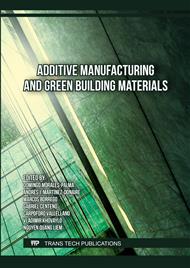p.61
p.71
p.81
p.91
p.99
p.107
p.117
p.127
p.135
The Tolerancing Obtained with Binder Jetting Additive Manufacturing Process in 17-4PH Steel - Case Study
Abstract:
Digital manufacturing is one of the pillars of Industry 4.0, additive manufacturing is certainly evolving very quickly, with more and more technologies being developed and materials being applied to this production area. However, with this growth and the capacity associated with this type of processes, it is extremely important to understand these processes, so that they can respond quantitatively and qualitatively to market needs. The present work intended to contribute to the improvement of the metal binder jetting process by simulating the manufacturing process of a proposed part, using the Simufact™ software and Desktop Metal software. After validating the parts with manufacturing with Binder jetting additive process. Subsequently, the metrological inspection and analysis of the respective results were carried out. Simulations were carried out for different values of powder size and density of the green part to assess their impact on the quality of the final part. The parts were produced in 17 – 4PH steel using a Shop System Desktop Metal machine. Were produced 5 parts with the following parameters, part (A) model with compensation obtained by Desktop software, part (B) model compensated by the Simufact additive software with 20% scale, part (C) model with scale 1: 1.2, part (D) model obtained by the Simufact additive software and part (E) model without scale. The measurements for the dimensional analysis were made with a digital caliper, while for the geometric analysis, measurements were made on a CMM machine.The simulations revealed smaller errors for larger granule sizes and also for larger green part densities. The inspection of the produced part, on the other side, exposed greater dimensional inaccuracy in X and less in Z direction. It also showed that, for the same element of the part, there is still a relationship between the ratio of the measured dimensions and the ratio of the deviations obtained. The results also showed that parts simulated by two software’s (A and D) are the ones with the best final quality, they presented smaller dimensional and geometric deviations in relation to the proposed model. The highest tolerance grades of these parts were in ISO standard IT15 and IT14 for part D and part A respectively.
Info:
Periodical:
Pages:
99-106
Citation:
Online since:
September 2023
Authors:
Keywords:
Price:
Сopyright:
© 2023 Trans Tech Publications Ltd. All Rights Reserved
Share:
Citation:



